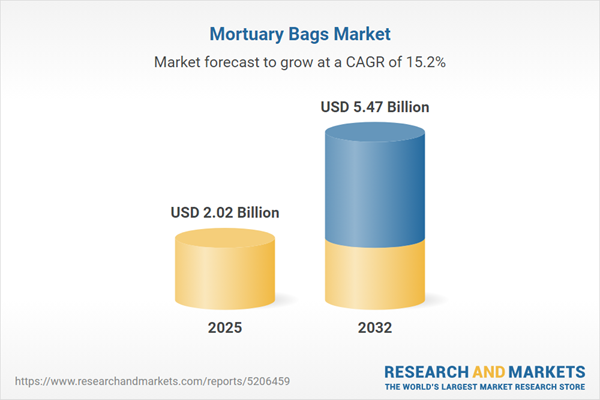Speak directly to the analyst to clarify any post sales queries you may have.
The mortuary bags market is adapting rapidly as senior decision-makers focus on compliance, sustainability, and supply continuity within institutional procurement. Organizations are reassessing supply chains to align with both regulatory and operational standards, identifying actionable strategies that mitigate risk while fostering agility.
Market Snapshot: Mortuary Bags Market Growth and Dynamics
The global mortuary bags market is witnessing significant expansion, propelled by evolving environmental legislation, institutional procurement priorities, and changing demographic trends. In 2024, the sector’s valuation reaches USD 1.75 billion, with projections rising to USD 2.02 billion by 2025 and climbing to USD 5.47 billion by 2032. Supported by a 15.23% compound annual growth rate (CAGR), this trajectory highlights growing emphasis on sustainable, compliant mortuary solutions. Institutions are responding to market dynamics by exploring innovative materials, forming robust supplier relationships, and modernizing procurement protocols. These shifts build resilience and adaptability within organizational supply chains.
Scope & Segmentation of the Mortuary Bags Market
- Material Types: Institutions are moving beyond conventional options like nonwoven fabrics, polyethylene, and PVC to integrate biodegradable and plant-based polymers, supporting both risk management and sustainability mandates.
- Bag Construction: Single- and double-layer designs, along with varied zipper configurations and integrated gussets, allow buyers to tailor product selection to specific requirements, ensuring streamlined handling and conformity to internal processes.
- End Users: Relevant segments include hospitals, funeral homes—both corporate and independent—service providers, and social care entities. Each faces distinct accreditation challenges and must align products with institutional protocols and regulatory expectations.
- Distribution Channels: Direct manufacturer sourcing, distributor partnerships, and digital procurement platforms provide flexibility in order management, cost tracking, and supplier benchmarking for procurement teams.
- Capacity Ranges: Mortuary bags are available in multiple sizes and capacities, enabling organizations to match products with diverse operational needs for secure and dignified procedures across environments.
- Regional Presence: The mortuary bags market maintains activity across the Americas, Europe, Middle East and Africa, and Asia-Pacific, where regulatory differences and supply approaches shape local procurement dynamics and supplier interactions with markets such as the U.S., Germany, China, and Australia.
- Key Suppliers: Leading market participants—Delaware limited liability company, The HYGECO Group, Classic Plastics Corporation, Auden Funeral Supplies Ltd, and Ferno-Washington Inc.—consistently drive product innovation and form critical nodes in global institutional supply networks.
Key Takeaways for Senior Decision-Makers
- Procurement leaders now prioritize mortuary bag contracts that feature certified sustainable inputs, furthering organizational ESG objectives and fostering compliance with emerging standards.
- Collaboration between manufacturers, raw material providers, and compliance entities has streamlined certification, promoting consistent operations across territories and sectors.
- Adaptable supplier management tools are supporting proactive identification of regulatory changes and helping organizations limit exposure to sourcing disruptions.
- Enhanced bag designs, including reinforced gussets and multiple layers, align with high-performance institutional needs while integrating smoothly into operational workflows and compliance checks.
- The adoption of digital procurement platforms—especially prevalent within Asia-Pacific—is refining vendor monitoring, improving process oversight, and enabling precision in large-scale purchasing for healthcare and service providers.
- Institutional transparency continues to improve due to expanded supplier traceability and increased attention to verified sustainability claims across different geographies.
Tariff Impact and Supply Chain Adaptation
Recent changes in tariffs on key raw materials have prompted institutions to reevaluate sourcing frameworks, expand their use of recycled materials, and diversify production sites geographically. Investments in advanced logistics infrastructures now play a direct role in securing reliable supply chains and in stabilizing input costs through volatile market conditions.
Methodology & Data Sources
Research draws on direct interviews with procurement executives and industry specialists, verified international trade data, competitive supplier benchmarking, and analysis of relevant patents. Continuous engagement with regulatory authorities ensures insights reflect up-to-date institutional priorities and evolving compliance requirements.
Why This Report Matters for Senior Decision-Makers
- Supports strategic evaluation of advanced material and sourcing models, empowering organizations to build resilient and compliant supply infrastructures.
- Presents actionable recommendations tailored to navigating regulatory changes, shifting tariffs, and region-specific procurement nuances, helping institutional buyers maintain continuity.
- Demonstrates the value of integrating sustainability and analytics in procurement, driving stronger transparency, deepened risk management, and greater operational consistency.
Conclusion
Organizations adopting agile sourcing strategies and sustainability-focused procurement will better align with compliance demands, strengthen continuity of supply, and enhance resilience within the evolving mortuary bags market.
Additional Product Information:
- Purchase of this report includes 1 year online access with quarterly updates.
- This report can be updated on request. Please contact our Customer Experience team using the Ask a Question widget on our website.
Table of Contents
3. Executive Summary
4. Market Overview
7. Cumulative Impact of Artificial Intelligence 2025
List of Figures
Companies Mentioned
The companies profiled in this Mortuary Bags market report include:- Delaware limited liability company
- The HYGECO Group
- Classic Plastics Corporation
- Auden Funeral Supplies Ltd
- Ferno-Washington Inc
Table Information
| Report Attribute | Details |
|---|---|
| No. of Pages | 193 |
| Published | November 2025 |
| Forecast Period | 2025 - 2032 |
| Estimated Market Value ( USD | $ 2.02 Billion |
| Forecasted Market Value ( USD | $ 5.47 Billion |
| Compound Annual Growth Rate | 15.2% |
| Regions Covered | Global |
| No. of Companies Mentioned | 6 |









